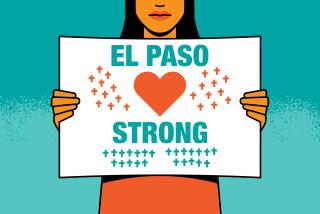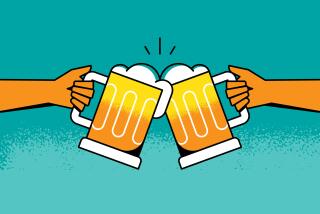Unabashed Texas Town Takes Issue with Its Bad Reputation
- Share via
SANTA FE, Texas — The billboards are as yellow as a lemon pie at the Busy Bee cafe. Along their borders, signatures spell out familiar names: mayor, fire chief, police chief. And the slogan--what could be more harmless?
“Santa Fe is no place for hate.”
But when local leaders joined Anti-Defamation League officials earlier this month to unveil the massive signs, the questions begged were clear.
“A lot of people were concerned [the signs] communicated that this is a place for hate,” school Supt. Richard Ownby said. “I had those concerns too--I think we’re being painted with a broad brush.”
Flanking the highway leading into Santa Fe, the billboards form a hall of mirrors for this town of 10,000 outside Galveston. Sponsored by the ADL, they reflect to some a plain reality--that Santa Fe is struggling with prejudice. But for many others in this community, the signs show, plain as day, that Santa Fe has been wrongly stigmatized.
The town made history in June, when the U.S. Supreme Court rejected school officials’ bid to protect student-led prayer before football games. The ruling capped five years of local activism, most of it supporting the school district. At the controversy’s height last spring, 4,000 spectators leaped up to cheer when a Santa Fe student declaimed a pregame prayer.
That passion, many locals say, brought unfriendly scrutiny from outsiders--who’ve now branded Santa Fe as intolerant. Instead, residents say, it’s simply a country town whose majority is Baptist, devout and unashamed of old-fashioned values.
Prayer Battle Isn’t the Only Incident
But a handful here read the cause and effect differently. The prayer battle, they say, unleashed an intolerance--both racial and religious--that had churned here quietly for decades.
Their complaints came to a head just before the Supreme Court’s prayer ruling. Thirteen-year-old Phillip Nevelow, Santa Fe’s lone Jewish student, alleged that schoolmates had threatened to hang him after two years of anti-Semitic harassment. Police have charged three boys with making terroristic threats. And, earlier this month, Nevelow’s parents filed a federal lawsuit against the school district. The school’s prayer crusade, they argued, had contributed to a climate of intolerance.
Proposed before the suit was filed, the cheery billboards were meant to ward off further episodes of this kind. But public reaction after the unveiling was cool.
“It may be a good reminder, but I think it gives a bad perspective of Santa Fe,” said Denise Rygaard, picking up her daughter from the high school’s Tribal Belles drill team practice. “Kids are cruel. I don’t care where you are.” Any problems in Santa Fe, she said, were eclipsed by racial and social problems in bigger cities.
A Ku Klux Klan History in Town
Ownby, who helped present the billboards, called the Nevelow episode overblown. “As with any incident, you’ve seen one side of the story,” he said.
But others--a smattering of locals and considerably more people in neighboring cities--see Santa Fe as something darker, even sinister. Something a sign might acknowledge but hardly change.
To these critics, the school prayer debate, Nevelow’s harassment and similar complaints by Mormon and Catholic students are linked to a local culture that welcomed Ku Klux Klan rallies in the 1980s.
“I think it’s all related,” said Galveston attorney Anthony Griffin, who successfully argued against Santa Fe in the football prayer case and who now represents the Nevelows. “Santa Fe is substantially different from the cities around it, more homogeneous in terms of race and religion. Santa Fe begged the world to look at it because of its position on prayer in school. Now Santa Fe is taking the position they’re being picked on.”
One white resident in her 20s, sweeping the entrance of a small business, coughed out an expletive when she heard about the signs.
“Do I think they’ll do anything?” she laughed harshly, before asking that her name not be used. “Are you kidding? I remember the other sign this town used to have. It said--I won’t use the word--’If you’re black, don’t let the sun set on you in Santa Fe.’ ”
Although accounts of that sign persist widely in local memory, it’s hard to find someone who saw it or can put a date to it. What has been documented is the KKK presence here in 1981, when white supremacists joined in a dispute against Vietnamese shrimpers in the nearby Gulf of Mexico.
In the 1990 census, Santa Fe had nine black residents. And it maintains a potent reputation for hate in the more diverse neighboring cities.
“Everybody knows about Santa Fe,” said Anthony Ross, a black oil field worker who lives in Dickinson. “They just don’t care for anybody that’s not white. You’re not wanted there, and you will be threatened.”
But David Fleming, a lifelong resident, said Santa Fe is neither the hotbed of evil--or old-fashioned virtue--that’s often depicted.
“Yes, there’s a lot of people who are going to say they’re with the KKK, at least mentally,” said Fleming, 29, who runs a lawn-care business. “But when you get them alone, you find they’re not. It’s just to improve their standing. Kids want to keep the tradition on, but they are not like that.”
Contemplating the noon glare from the cool of the Busy Bee, Fleming said the key to Santa Fe was not its religious fervor, but its size.
Houston’s sprawl--and big-city culture--will overtake this small town soon, he said. The Computer Age will do its work too. Fleming recalled how his brother, a devotee of online chat rooms, was stunned to discover that he was close friends with a black woman.
But Santa Fe remains a haven for people who want homogeneity, isolation and predictability, Fleming said. And with that, he said, comes mischief.
“It’s a small country town,” he said. “There’s nothing. No movies, no mall. There’s so little to do, people are so bored, there’s nothing to do but harass people.”
More to Read
Sign up for Essential California
The most important California stories and recommendations in your inbox every morning.
You may occasionally receive promotional content from the Los Angeles Times.













